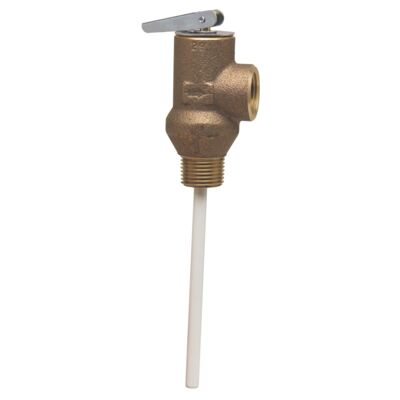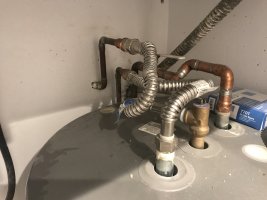-
Welcome to the new and improved Building Code Forum. We appreciate you being here and hope that you are getting the information that you need concerning all codes of the building trades. This is a free forum to the public due to the generosity of the Sawhorses, Corporate Supporters and Supporters who have upgraded their accounts. If you would like to have improved access to the forum please upgrade to Sawhorse by first logging in then clicking here: Upgrades
You are using an out of date browser. It may not display this or other websites correctly.
You should upgrade or use an alternative browser.
You should upgrade or use an alternative browser.
TPR Discharge Pipe in existing condo
- Thread starter jar546
- Start date
chris kennedy
Sawhorse
Have them fixed as you see them, your doing your job as the inspector notifying them it's a violation.
That's some real crap work that may have not been inspected?
3/4-inch discharge line should not be reduced down to 1/2-inch piping through the wall. I will not allow PEX due to it being a (Insert) reducing fitting.
The bad thing about this photo, it might work, don't know what's on the other side of the wall?
That's some real crap work that may have not been inspected?
3/4-inch discharge line should not be reduced down to 1/2-inch piping through the wall. I will not allow PEX due to it being a (Insert) reducing fitting.
The bad thing about this photo, it might work, don't know what's on the other side of the wall?
north star
Sawhorse
- Joined
- Oct 19, 2009
- Messages
- 4,596
# ~ #
Where does the T & P Relief Valve go to, ....a
compliant location ?........Does that Quick Shut Off
Valve handle have enough actual room to be
functional ?
Inquiring minds wanna know !
# ~ #
Where does the T & P Relief Valve go to, ....a
compliant location ?........Does that Quick Shut Off
Valve handle have enough actual room to be
functional ?
Inquiring minds wanna know !
# ~ #
ICE
Oh Well
Considering that the building is a highrise that was built decades ago I don’t think it will be possible to change it up now.
steveray
SAWHORSE
I would cite it and let them appeal in any way they can....That way no one could ever say they didn't know it was a dangerous situation....
jar546
Forum Coordinator
The reduction in size without an airgap in the same room is a big issue. This needs to go to a pan with 3/4" pipe then from the pan through another 3/4" pipe.
Regardless of what is existing, it is a violation of IPC and in the FBC that would be 504.6, 504.7
Regardless of what is existing, it is a violation of IPC and in the FBC that would be 504.6, 504.7
ICE
Oh Well
My Mechanical code has this: Discharge from a relief valve into a water heater pan shall be prohibited.
A pan drains by gravity and a TPRV has enormous pressure. The pan would overflow immediately.
A pan drains by gravity and a TPRV has enormous pressure. The pan would overflow immediately.
jar546
Forum Coordinator
My Mechanical code has this: Discharge from a relief valve into a water heater pan shall be prohibited.
A pan drains by gravity and a TPRV has enormous pressure. The pan would overflow immediately.
So California requires what for TPR discharge?
ICE
Oh Well
There's a bunch of requirements. The one I quoted was #7.So California requires what for TPR discharge?
#3 Discharge pipe shall discharge independently by gravity through an air gap into the drainage system or outside of the building with the end of the pipe not exceeding 2 feet (610 mm) and not less than 6 inches (152 mm) above the ground and pointing downwards.
My Mechanical code has this: Discharge from a relief valve into a water heater pan shall be prohibited.
What does your UPC say about discharging into a WH pan?
jar546
Forum Coordinator
There's a bunch of requirements. The one I quoted was #7.
#3 Discharge pipe shall discharge independently by gravity through an air gap into the drainage system or outside of the building with the end of the pipe not exceeding 2 feet (610 mm) and not less than 6 inches (152 mm) above the ground and pointing downwards.
So where do you place your air-gap to a drainage system?
ICE
Oh Well
So where do you place your air-gap to a drainage system?
Laundry sink, mop sink.
ICE
Oh Well
Not a lot.What does your UPC say about discharging into a WH pan?
504.6 Temperature, Pressure, and Vacuum Relief Devices. Temperature, pressure, and vacuum relief devices or combinations thereof, and automatic gas shutoff devices, shall be installed in accordance with the terms of their listings and the manufacturer’s installation instructions. A shutoff valve shall not be placed between the relief valve and the water heater or on discharge pipes between such valves and the atmosphere. The hourly British thermal units (Btu) (kW•h) discharge capac- ity or the rated steam relief capacity of the device shall be not less than the input rating of the water heater.
505.2 Safety Devices. Storage-type water heaters and hot water boilers deriving heat from fuels or types of energy other than gas, shall be provided with, in addition to the primary temperature controls, an overtemperature safety protection device constructed, listed, and installed in accordance with nationally recognized applicable standards for such devices and a combination temperature and pressure-relief valve.
Mr. Inspector
SAWHORSE
My Mechanical code has this: Discharge from a relief valve into a water heater pan shall be prohibited.
A pan drains by gravity and a TPRV has enormous pressure. The pan would overflow immediately.
Big difference in codes. The IPC doesn't require the pan to hold all the water that may come from the TPRV:
504.7.1 Pan size and drain. The pan shall be not less than
11/2 inches (38 mm) in depth and shall be of sufficient size
and shape to receive all dripping or condensate from the
tank or water heater. The pan shall be drained by an indirect
waste pipe having a diameter of not less than 3/4 inch
(19 mm). Piping for safety pan drains shall be of those
materials listed in Table 605.4.
504.6 Requirements for discharge piping.
5. Discharge to the floor, to the pan serving the water
heater or storage tank, to a waste receptor or to the
outdoors.
Never saw one discharge to a storage tank. There doesn't seem to be any requirements for this storage tank. I wonder if a bucket would be OK?
Mr. Inspector
SAWHORSE
Note that IPC 504.7 only requires the pan where water leakage from the tank can cause damage, so a concrete floor with a floor drain near by would IMO not require a pan. Do others see it this way?
i agree.
mtlogcabin
SAWHORSE
If it is a concrete floor with carpet, linoleum or laminate floor covering damage will occur
The SBCCI required the T&P pipe to discharge to the outside to an approved location. Like the UPC it did not allow it to discharge to the drain pan like the IPC allows.
Codes change over the years and what is not allowed today was allowed in the past. Obviously the water heater is not the original and there where water heaters that had T&P valves that have a 1/2 discharge size
Filter results
Protection Type
Temperature And Pressure
Outlet Connection Type
Female Threaded
Outlet Connection Size
1/2 IN
Maximum Working Pressure-PSI
113
Lead Free
YES
Inlet Connection Type
Male Threaded
Inlet Connection Size
1/2 IN
Brand Name
Watts
Body Material
Lead Free Copper Silicon Alloy
Discontinued
Show Discontinued Products

Watts
LF1L
Lead Free* Temperature and Pressure
Go to the code when the building was originally built. It may have been a legal installation at the timeHow would you handle this situation knowing that dozens of other condos in this high-rise have been piped this way for decades?
The SBCCI required the T&P pipe to discharge to the outside to an approved location. Like the UPC it did not allow it to discharge to the drain pan like the IPC allows.
Codes change over the years and what is not allowed today was allowed in the past. Obviously the water heater is not the original and there where water heaters that had T&P valves that have a 1/2 discharge size
Filter results
Protection Type
Temperature And Pressure
Outlet Connection Type
Female Threaded
Outlet Connection Size
1/2 IN
Maximum Working Pressure-PSI
113
Lead Free
YES
Inlet Connection Type
Male Threaded
Inlet Connection Size
1/2 IN
Brand Name
Watts
Body Material
Lead Free Copper Silicon Alloy
Discontinued
Show Discontinued Products
Watts
LF1L
Lead Free* Temperature and Pressure

